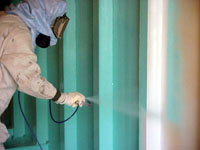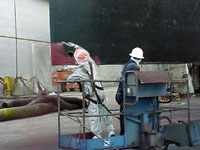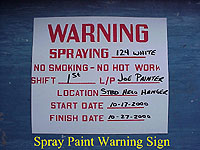Shipyard Employment eTool
PPE Selection >> Painting

OSHA hierarchy of controls is:
- Engineering Controls
- Administration Controls
- Personal Protective Equipment (PPE)
Painting operations require preplanning and evaluation of the area for potential hazards before work is begun. Usually, a Shipyard Competent Person (SCP), Certified Industrial Hygienist (CIH), or Certified Marine Chemist (CMC) are needed to assist with the hazard evaluation and selection of PPE. Additional hazards exist when work is done in enclosed or confined spaces. (See Confined or Enclosed Space).
Painting operations present a variety of hazards associated with the application of paints and other coatings. In addition to skin absorption and inhalation of toxic chemicals, fire and explosion hazards are of primary concern. PPE must be used if adequate engineering and administrative controls are not feasible means to control potential hazards.
Typical painting operations include:
Each of these painting operations may present unique hazards. Therefore, a qualified person must select PPE based on the specific operation and chemicals used. Use of appropriate combinations of the following PPE will provide adequate protection:
Review the General Shipyard Worker PPE before proceeding with this section.

PPE is required when performing spray applications and must provide protection from exposure to liquids, vapors, or mists that present inhalation, skin contact or absorption hazards. Care should be taken in the selection of the protective clothing fabric to ensure protection against the solvents or solids. In addition, consideration should be given to the potential for exposure to paint components (such as epoxies, isocyanates) that may cause severe allergic reaction. Because many paints are highly flammable, special precautions may be necessary to minimize fire and explosion hazards.
Note: During these operations it is important to have an emergency eye and body flushing station.

PPE is required when performing hand application and must provide protection from exposure to liquids or vapors which present inhalation, skin contact, or absorption hazards. Care should be taken in the selection of the protective clothing fabric to ensure protection against the solvents or solids. In addition, consideration should be given to the potential for exposure to paint components (such as, epoxies, isocyanates) that may cause severe allergic reaction. Because many paints are highly flammable, special precautions may be necessary to minimize fire and explosion hazards.
Note: During these operations, it is important to have an emergency eye and body flushing station.

Potential Hazards
- Chemical absorption due to skin exposure to solvents and paints
- Static electricity as a source of ignition produced while working in protective clothing and boots
- Heat-related illnesses due to a combination of PPE use, heat-producing equipment, work activity, and environmental conditions. See Painting: Work Environmental Temperature-Related Hazards
Requirements and Example Solutions
- PPE should provide skin protection from toxic paints and solvents that may be spilled, sprayed, or splashed during their use.
- Attached hoods should be used and when there is head or neck exposure.
- When respirators are used, hoods should be tightened over the respirator to prevent interference with the face seal and allow proper removal of gear.
- Heat stress programs should be used.
- When flammable solvents are used in painting, non-static discharge producing outer clothing must be used. [29 CFR 1915.35(b)(9)]
For more detailed information, review Hand and Body Protection.

Potential Hazards
- Worker inhalation exposure to toxic paints or solvents
- Exposure to oxygen-deficient atmospheres

Requirements and Example Solutions
- Respirators protect the lungs and upper respiratory track from mists, fumes, and vapors associated with the paints and solvents.
- Workers spray painting in confined spaces must be protected by airline respirator. [29 CFR 1915.35(a)(1)]
- Workers spray painting in enclosed spaces must be protected by air-line respirators unless ventilation is adequate enough to reduce atmospheric concentrations. If so, air-purifying respirators can be used. [29 CFR 1915.35(a)(1)(ii)]
- All workers continuously in a compartment where spray painting is being performed must be protected by air-line respirators. Workers in the compartment for a short duration may wear air-purifying respirators. [29 CFR 1915.35(b)(13)]
- Workers brush painting in confined spaces without adequate ventilation must wear air-purifying respirators. [29 CFR 1915.35(a)(2)]
Note: If highly volatile, toxic materials are applied, proper respiratory protection may be the same as that for the spraying material (aerosol carrier). Personal air sampling will determine the type of respiratory protection required.
For more detailed information, review Respiratory Protection.

Potential Hazards
- Paint injection due to high-pressure equipment
- Static electricity as a source of ignition produced while working in protective clothing and boots
- Chemical absorption due to skin exposure to toxic paints and solvents

Requirements and Example Solutions
- Boots (for example chemical resistant, or waterproof) should provide skin protection from toxic paints or solvents that may be spilled, sprayed, or splashed during their use.
- If flammable solvents are involved in the operation, non-static discharge producing shoes/boots and shoe covers must be used. [29 CFR 1915.35(b)(9)]
- Boots should be worn with the legs of the protective clothing over them to prevent liquids from entering the boots.
- Protective impermeable covers should be used over the shoes/boots when shoes/boots are not liquid proof.
- Slip-resistant soled boots should be worn when working on slippery surfaces.
For more detailed information, review Foot Protection.

Potential Hazards
- Chemical absorption due to skin exposure to toxic paints or solvents.
- Static electricity as a source of ignition produced while working in gloves.
Requirements and Example Solutions
- PPE should provide skin protection from:
- Toxic paints or solvents that may be spilled, sprayed or splashed during their use
- Paint injection during high-pressure spraying
- Gloves should be sealed to the protective clothing to prevent liquids from entering the glove.
- For specific operations, inner gloves may be required.
- Gloves should be under the sleeves of the protective clothing or sealed to them with tape.
- If flammable solvents are involved in the operation, non- static discharge producing gloves must be used. [29 CFR 1915.35(b)(9)]
For more detailed information, review Hand and Body Protection.

